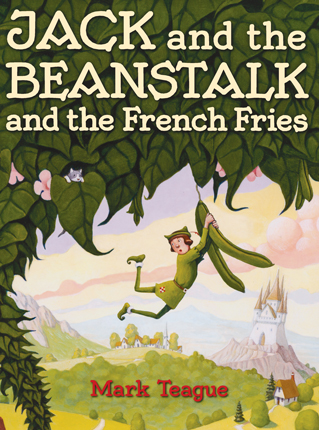Full Text Reviews: School Library Journal - 06/01/2017 PreS-Gr 2—When Jack's mother throws the result of his bad bargain out the window, a great bean-giving stalk sprouts and leads to dinners of baked, minced, mashed, and pickled beans. Though thankful he is no longer hungry, Jack quickly develops the bean blues. His neighborly mother shares their good fortune, making Jack unpopular with the village kids, who are now in the same bean-filled boat. When Jack, "the bean kid," receives only bean-themed birthday presents, it is the last straw—he has to get rid of the beanstalk. During a surprise encounter, Jack and the giant discover they are both tired of eating nothing but nutritious, boring beans, and after sharing in an epic bean-throwing tantrum, they end up playing for the same side. On the sound advice of the giantess, who suggests, "If you don't like beans, plant something else," Jack and the giant team up on an agricultural enterprise that produces a feast for villagers and giants alike. The text is clear and humor-filled, but the layered painted illustrations tell a hilarious story without the help of words. Each character, particularly Jack's dramatic cow, is crafted with nuanced facial and physical expressions that articulate the action taking place. Details in the artwork make this adventure special; watch for mysterious eyes peeping out from under a rock near the giant's castle, framed photos of fairy-tale heroes hanging on the wall of Jack's house, and bean recipe books in Mrs. Giant's kitchen. VERDICT This delightfully illustrated twist on a classic has a traditional beginning that veers wildly out of familiar territory when the villain turns out to be not the giant but a sustaining and boring beanstalk that proves you can certainly have too much of a good thing. A super read-aloud selection.—Lauren Younger, New York Public Library - Copyright 2017 Publishers Weekly, Library Journal and/or School Library Journal used with permission. Booklist - 06/01/2017 This twist on the Jack and the Beanstalk fairy tale is set in a fanciful medieval European village and includes most of the story’s traditional elements. The gold, harp, and goose make cameos, but food is the important commodity. Unfortunately, the beanstalk produces an overabundance of beans, and everyone (including the giant) is sick of eating them, even though they’re “nutritious and delicious and, best of all, they’re free.” Jack and the giant bond over their disgust of beans and a desire for french fries. When they throw beans around in protest, the giant’s wife strongly suggests they plant a vegetable garden for variety. The plants in their garden prove just as abundant as the beanstalk, producing food for everyone—including plenty of potatoes for french fries. While the well-crafted, lively text packs plenty of subtle humor and appropriate exaggeration, it is Teague’s artwork, with his sculptural figures and lush backdrops, that makes the story soar. Good storytelling with a thought-provoking moral: when life gets boring, plant a new garden. - Copyright 2017 Booklist. Loading...
|



